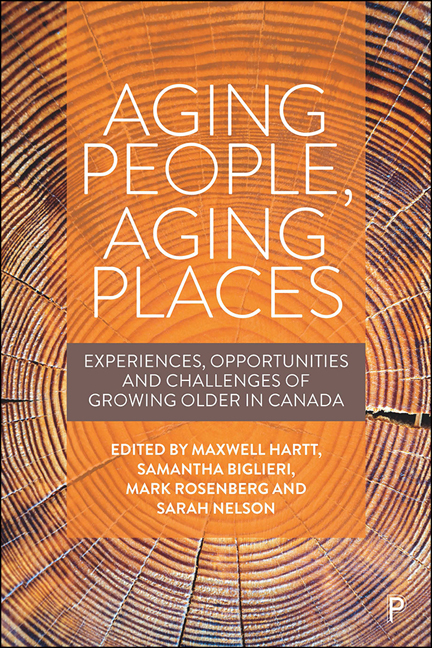11 - Aging in rural Canada
Published online by Cambridge University Press: 18 December 2021
Summary
In this overview chapter, we call upon data from Statistics Canada and the academic literature to present some stylized facts and figures regarding rural older adults and a synthesis of the challenges and opportunities of aging in rural environments. This chapter serves to provide (1) a snapshot of Canadian rural demographic trends, (2) an overview of the state-of-the-art thinking on rural aging, and (3) contextual framing for the in-depth research chapters and vignettes that make up the rural part of this book.
Anyone remotely familiar with Canada's geography would not be surprised to learn that by land area, Canada is predominantly rural. Concentrated areas of population cover very little of Canada's expansive 9.9 million square kilometres. Upwards of 90% of the Canadian population live within 160 kilometres of the almost 9,000-kilometre-long Canada–US border (CBC News, 2009). In short, the vast majority of Canada is sparsely populated.
Broadly speaking, we consider these sparsely populated places to be rural. Although there is no single perfect definition of a rural environment, rural can be operationally defined as an area with a population density under than 400 people per square kilometre (Channer et al, 2020). Using data from Statistics Canada (2019) population estimates, we found that 8.5 million of Canada's roughly 35 million people live in rural areas. Of those 8.5 million, approximately 1.5 million are aged 65 and over. Like everywhere in Canada, the cohort of Canadians aged 85 and over is growing quickly. Almost 150,000 rural Canadians are 85 years of age or over (Statistics Canada, 2019). Canada's rural population is aging faster than its urban and suburban counterparts. Older Canadians, aged 65 and over, make up 18% of Canada's rural population in comparison to 17% of the suburban population and 15% in urban areas. More than a quarter of Canadians aged 65 or older live in rural areas, as proportionately, the population of older Canadians tends to be higher in rural areas (Menec et al, 2015). Canadian rural populations also have a higher ratio of older adults to working-age adults (known as the old-age dependency ratio). The growing intergenerational imbalance is explained by the dual process of (1) rural youth migration to urban centres for employment, and (2) older Canadians relocating from urban and suburban to rural areas for retirement (Forbes and Hawranik, 2012).
- Type
- Chapter
- Information
- Aging People, Aging PlacesExperiences, Opportunities and Challenges of Growing Older in Canada, pp. 141 - 148Publisher: Bristol University PressPrint publication year: 2021
- 1
- Cited by



